
Station Name: ELSLACK[Source: Alan Young]
 The up platform at Elslack station looking north-east c1905. The platform arrangement is staggered with the down platform behind the photographer on the far side of the bridge over Elslack Lane. The single-storey brick building with the hipped roof contains the booking office and waiting rooms. Window and door and window openings have segmental arches and dentillation of the cornices provides some decoration. Beyond is the two-storey stationmaster’s house, brick-built with an overhanging steeply pitched, slate roof, broken by a gabled dormer. The signal box is several yards north-east of the platform ramp. The running-in board illustrates Midland Railway practice of providing two adjoining boards set at angles to enable the station name to be read easily from both up and down directions. Oil lighting is provided in casement lamps fixed to the building and on posts. Milk churns, empty barrows and an unceremoniously inverted advertising sign provide interest in the foreground. The goods depot is seen to the right, but the camera angle misses the goods warehouse.
Copyright photo from John Alsop Collection  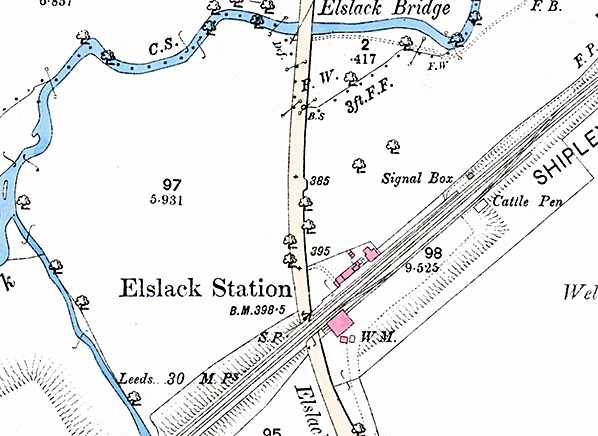
1894 1: 2,500 OS map. The up platform is shown with the passenger building (internal divisions indicated) and the station house to the north-east. The signal box is north-east of the platform. The goods facilities face the up platform, consisting of a loop off the down through line serving a single-road warehouse (not named) on a short spur at the south-west end; the weigh office (W.M.=weighing machine) is adjacent to the warehouse. A cattle pen adjoins the opposite end of the loop. No down platform is shown on this or any other OS map, however its location was south-west of the bridge over Elslack Lane as seen on one of the accompanying photographs.
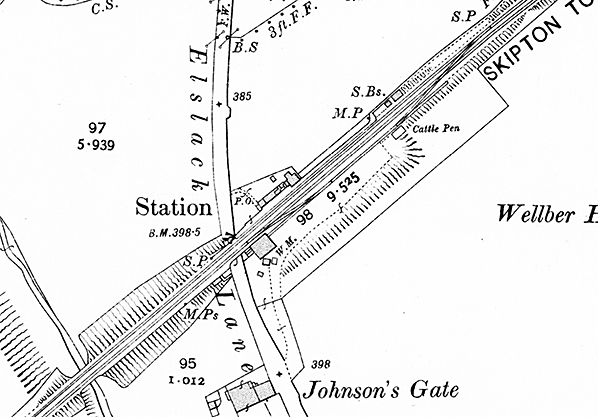
1909 1: 2,500 OS map. An interesting change since 1894 is that two signal boxes are now shown side by side at Elslack station: presumably the larger one has replaced the smaller one. There is still no down platform on the map although a small structure has appeared on the down side of the line beside the bridge. This is possibly the timber building seen on the 1952 photograph.
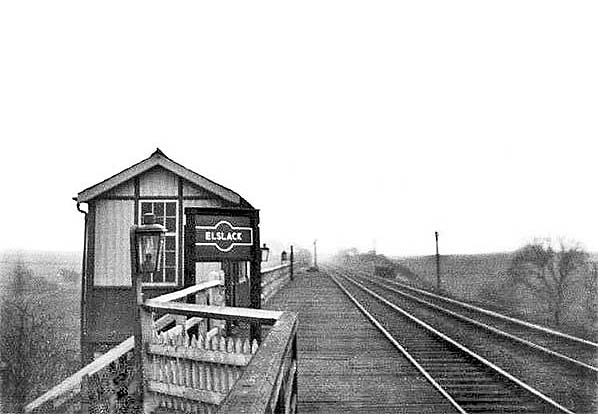 The down platform at Elslack station is seen in 1952, the year of its closure, looking south-west. It is of timber construction perhaps because it is on an embankment where a masonry structure could have been too heavy. The enclosed waiting room in a small timber building supported on struts. An LMS ‘Hawkseye’ running-in nameboard is installed at an angle enabling it to be more easily read from entering trains (by passengers facing forwards). It is possibly mounted on two of the three posts that the Midland Railway would have installed for its distinctive nameboards, as seen on the older view of the up platform. The casement oil lanterns are of a cruder style than seen on the up platform. The different style of lamps suggests that this platform was built at a different time from the up platform.
Photo from John Mann collection 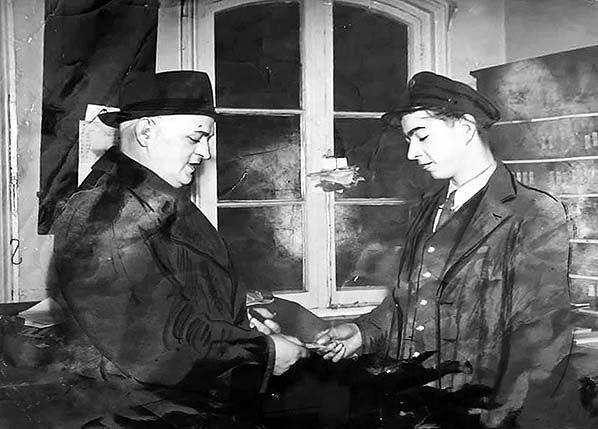
Elslack ticket office on the last day of public service in 1952. Junior porter Tony Millington sells the last ticket from Elslack to Skipton to reporter I I Illingworth. Photo from Debbie Green (Tony Millington was her dad) 
The up platform of the disused Elslack station looking west in April 1976. The stationmaster’s house stands derelict, its windows and doorway boarded up, and part of the platform has collapsed. Nothing remains of the station building which formerly stood to the left of the house. The tracks through the station were removed soon after the line closed in 1970, and agricultural equipment is occupying the trackbed. At this date nothing remains of the timber down platform which was staggered south-west of the up platform.
Photo by Alan Young 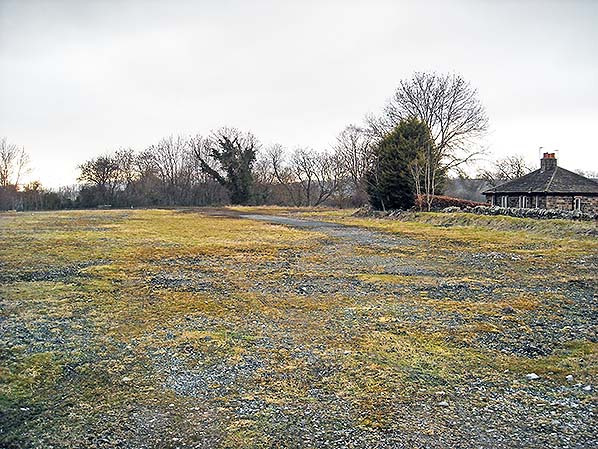
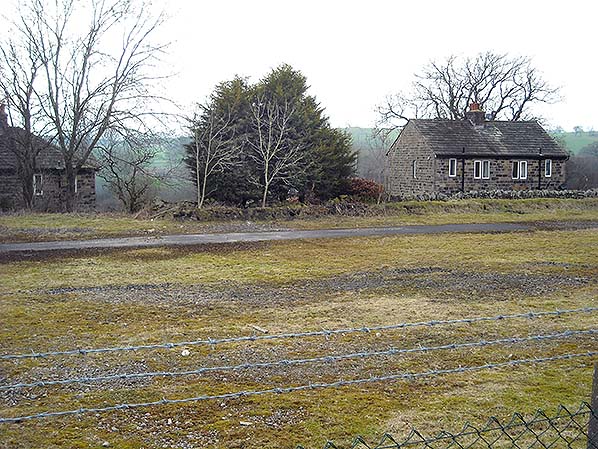
Looking north-west at the site of Elslack station in February 2017. Fragments of the former up platform can be seen between the two houses.
Photo by Alan Young 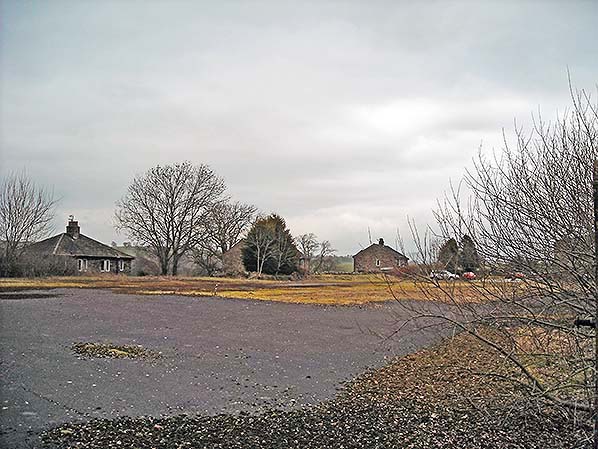 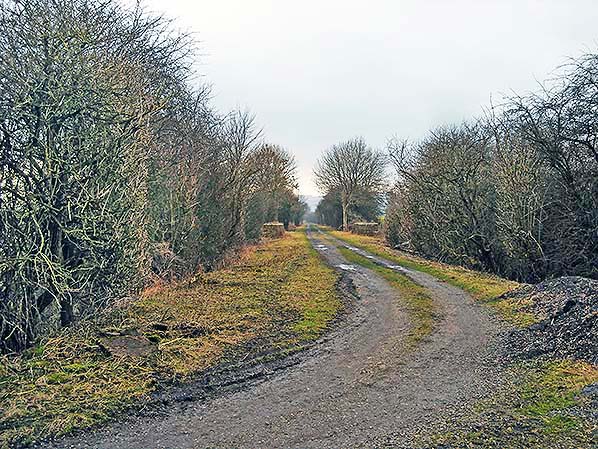
Looking south-west in February 2017 along the trackbed of the Colne Branch at Elslack. The station platforms were staggered; the up platform was behind the camera and the down was directly ahead, on the left side of the trackbed stretching as far as the stone bridge parapet. This platform was of timber construction and has been removed without trace.
Photo
by Alan Young
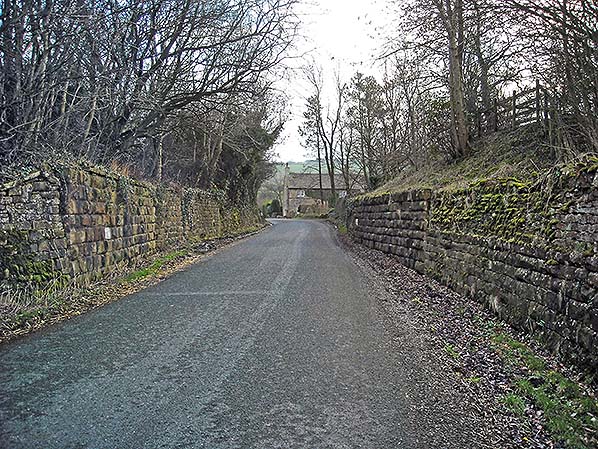
Looking south-east along Elslack Lane in February 2017. The abutments of the Colne Branch railway bridge are ahead. The down (Colne-bound) platform was located several yards to the right of the fence seen on the truncated railway embankment.
Photo by Alan Young
|
 The station’s platforms were staggered either side of the bridge over Elslack Lane, the up (Skipton-bound) platform being displaced north-east of the down platform. The main facilities were towards the south-western end of the up platform. The original station building was moved here from Shipley where it had been considered inadequate; the Midland Railway traffic committee made this decision in October 1849. Binns (2008) assumes that it was of timber construction. The permanent station building in which the booking office and waiting facilities were found was of brick construction, a single-storey structure of modest dignity. The roof was hipped and the door and window openings were segmental arches. Some decoration was supplied by dentillation of the cornices. The building at Thornton-in-Craven, the next station towards Colne, was of the same style. The stationmaster’s house stood immediately north-east of the station building. This was a brick-built, two-storey affair with an overhanging steeply pitched, slate roof, broken by a gabled dormer on the platform elevation. The north-east gable end was rendered and distinguished by unusually narrow windows on both storeys. The signal box was several yards north-east of the up platform ramp.
The station’s platforms were staggered either side of the bridge over Elslack Lane, the up (Skipton-bound) platform being displaced north-east of the down platform. The main facilities were towards the south-western end of the up platform. The original station building was moved here from Shipley where it had been considered inadequate; the Midland Railway traffic committee made this decision in October 1849. Binns (2008) assumes that it was of timber construction. The permanent station building in which the booking office and waiting facilities were found was of brick construction, a single-storey structure of modest dignity. The roof was hipped and the door and window openings were segmental arches. Some decoration was supplied by dentillation of the cornices. The building at Thornton-in-Craven, the next station towards Colne, was of the same style. The stationmaster’s house stood immediately north-east of the station building. This was a brick-built, two-storey affair with an overhanging steeply pitched, slate roof, broken by a gabled dormer on the platform elevation. The north-east gable end was rendered and distinguished by unusually narrow windows on both storeys. The signal box was several yards north-east of the up platform ramp. 
 At nationalisation in 1948 Elslack passed into British Railways’ London Midland Region administration. In the summer 1950 timetable, below, Elslack was the only intermediate station between Skipton and Colne to have lost its Sunday train service. Elslack and its neighbouring station of Thornton-in-Craven had a noticeably poorer service than the other two intermediate stations between Skipton and Colne but, remarkably, Thornton survived until the closure of the line in 1970. Nevertheless, the timetable enables workers, shoppers and scholars to travel to and from Skipton, but night-time revelry in the town is not catered for.
At nationalisation in 1948 Elslack passed into British Railways’ London Midland Region administration. In the summer 1950 timetable, below, Elslack was the only intermediate station between Skipton and Colne to have lost its Sunday train service. Elslack and its neighbouring station of Thornton-in-Craven had a noticeably poorer service than the other two intermediate stations between Skipton and Colne but, remarkably, Thornton survived until the closure of the line in 1970. Nevertheless, the timetable enables workers, shoppers and scholars to travel to and from Skipton, but night-time revelry in the town is not catered for.  Both passenger and goods traffic at this station were minimal and the station closed to all traffic on 3 March 1952. The timber down platform had been dismantled by the mid 1970s – perhaps much earlier - but the up platform was still in place in a dilapidated state in 1976. At this time the main building had been demolished but the derelict station house remained on the up platform. In 2017 Brookbank Industries, a manufacturer of textile accessories, has its factory on the down side of the old railway, north-east of the dismantled railway bridge. Fragments of the up platform remain, but the station house has gone without trace.
Both passenger and goods traffic at this station were minimal and the station closed to all traffic on 3 March 1952. The timber down platform had been dismantled by the mid 1970s – perhaps much earlier - but the up platform was still in place in a dilapidated state in 1976. At this time the main building had been demolished but the derelict station house remained on the up platform. In 2017 Brookbank Industries, a manufacturer of textile accessories, has its factory on the down side of the old railway, north-east of the dismantled railway bridge. Fragments of the up platform remain, but the station house has gone without trace.
 Home Page
Home Page